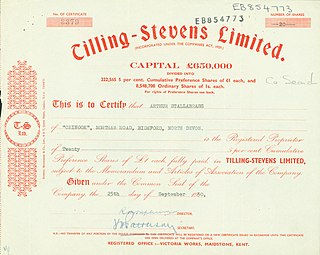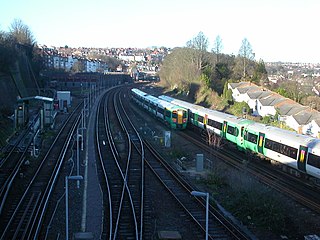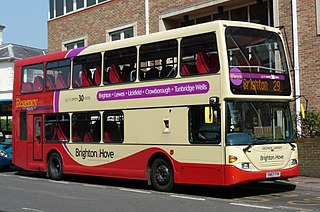
Amberley Museum is an open-air industrial heritage museum at Amberley, near Arundel in West Sussex, England. The museum is owned and operated by Amberley Museum and Heritage Centre, a not-for-profit company and registered charity, and has the support of an active Friends organisation. The items in the Museums collection are held by The Amberley Museum Trust

Worthing is a seaside town in West Sussex, England, at the foot of the South Downs, 10 miles (16 km) west of Brighton, and 18 miles (29 km) east of Chichester. With a population of about 110,000 and an area of 12.5 square miles (32.4 km2), the borough is the second largest component of the Brighton and Hove built-up area, the 15th most populous urban area in the United Kingdom. Since 2010, northern parts of the borough, including the Worthing Downland Estate, have formed part of the South Downs National Park. In 2019, the Art Deco Worthing Pier was named the best in Britain.

Shelvoke and Drewry was a Letchworth, Hertfordshire manufacturer of special purpose commercial vehicles. It was best known for its innovative waste collection vehicles that were the preferred choice of municipal authorities in the UK together with their gully emptiers, cesspool cleaning vehicles and street watering and washing vehicles.
Harry Shelvoke (1877–1962) was one of the founding members of the British coachbuilding and engineering company Shelvoke and Drewry.

Tilling-Stevens was a British manufacturer of buses and other commercial vehicles, based in Maidstone, Kent. Originally established in 1897, it became a specialist in petrol-electric vehicles. It continued as an independent manufacturer until 1950, when it was acquired by the Rootes Group.

Public transport in Brighton and Hove, a city on the south coast of England, dates back to 1840. Brighton and Hove has a major railway station, an extensive bus service, many taxis, coach services, and it has previously had trolley buses, ferries, trams, auto rickshaws and hydrofoils.

Southdown Motors Services Ltd was a bus and coach operator in East and West Sussex and parts of Hampshire, in southern England. It was formed in 1915 and had various owners throughout its history, being purchased by the National Bus Company (NBC) in 1969. The company fleet name was lost when it was acquired by the Stagecoach Group in 1989 but buses operated under that legal name until 2015 when the operating licence was transferred to another company within the Stagecoach Group and 1915 company became dormant but still owned by the Stagecoach Group.

Charles H Roe was a Yorkshire coachbuilding company. It was for most of its life based at Crossgates Carriage Works, in Leeds.
Dennis Eagle Limited is a UK-based bin lorry manufacturer owned by Terberg RosRoca Group, Europe’s largest refuse collection vehicle manufacturer and the second largest refuse collection vehicle manufacturer in the world.
Open top buses are used in the United Kingdom for sightseeing and seasonal summer services.
Worthing, a seaside town with borough status in the United Kingdom, is connected to the rest of the country by a network of major roads, a mainline railway, frequent bus and coach services and a nearby airport. Its 19th-century growth was encouraged by the development of turnpikes and stagecoach routes to London and nearby towns. By the middle of that century railway services improved journey times and conditions significantly. Suburbanisation in the 20th century was assisted by a network of bus routes.

Worthing, a seaside resort on the English Channel coast of West Sussex, southeast England, has a long maritime history predating its late 18th-century emergence as a fashionable holiday and residential town. Fishing was a major economic activity for centuries, and still retains a small presence on Worthing's shingle shoreline. Smuggling, usually by sea, also contributed to the growing town's economy. The formerly sandy beach has changed over time, partly because of sea defence work carried out to alleviate concerns over flooding, which has affected the town several times. Large seaweed deposits, driven up from the sea bed, have caused occasional problems, while undersea rock formations off the coast have national importance as a wildlife habitat. There have been many shipwrecks and groundings in the area, and lifeboats were stationed in the town for many years.
Thomas Lainson (1825–1898) was a British architect. He is best known for his work in the East Sussex coastal towns of Brighton and Hove, where several of his eclectic range of residential, commercial and religious buildings have been awarded listed status by English Heritage. Working alone or in partnership with two sons as Lainson & Sons, he designed buildings in a wide range of styles, from Neo-Byzantine to High Victorian Gothic; his work is described as having a "solid style, typical of the time".

Tillingbourne Bus Company was a bus company based in Cranleigh, Surrey. The company operated bus and coach services in Surrey, West Sussex, Hampshire and Berkshire from 1924 until 2001.

The Regency Route is a name given since 1977 to a regular bus service between Brighton in East Sussex and Tunbridge Wells in Kent, both towns with a Regency heritage. The route runs via the East Sussex towns of Lewes, Uckfield and Crowborough.

Buses in Portsmouth are a form of public transport in the city of Portsmouth, England. Motor bus services in Portsmouth began in 1919, and were expanded in the 1930s following the closure of the Portsmouth Corporation Transport tram network. Trolleybuses were also operated between 1934 and 1963. Until 1988 the majority of services were provided by Portsmouth Corporation Transport, a municipal bus company owned by Portsmouth City Council. Other services into the city were operated by Southdown Motor Services, latterly as a subsidiary of the National Bus Company.

Coastliner 700 is a bus service operated in West Sussex and south east Hampshire, England, by Stagecoach South between Brighton and Southsea via Worthing, Littlehampton, Wick, Bognor Regis, Chichester, Havant, and Portsmouth with a general daytime frequency of every ten minutes. The route has its own livery and is usually operated with double-decker buses.

The Norfolk Hotel is a 4-star hotel in the seaside resort of Brighton, part of the English city of Brighton and Hove. Designed in 1865 by architect Horatio Nelson Goulty, it replaced an earlier building called the Norfolk Inn and is one of several large Victorian hotels along the seafront. The French Renaissance Revival-style building, recalling E.M. Barry's major London hotels, is "tall, to make a show": the development of the passenger lift a few years earlier allowed larger hotels to be built. It is a Grade II listed building.
















